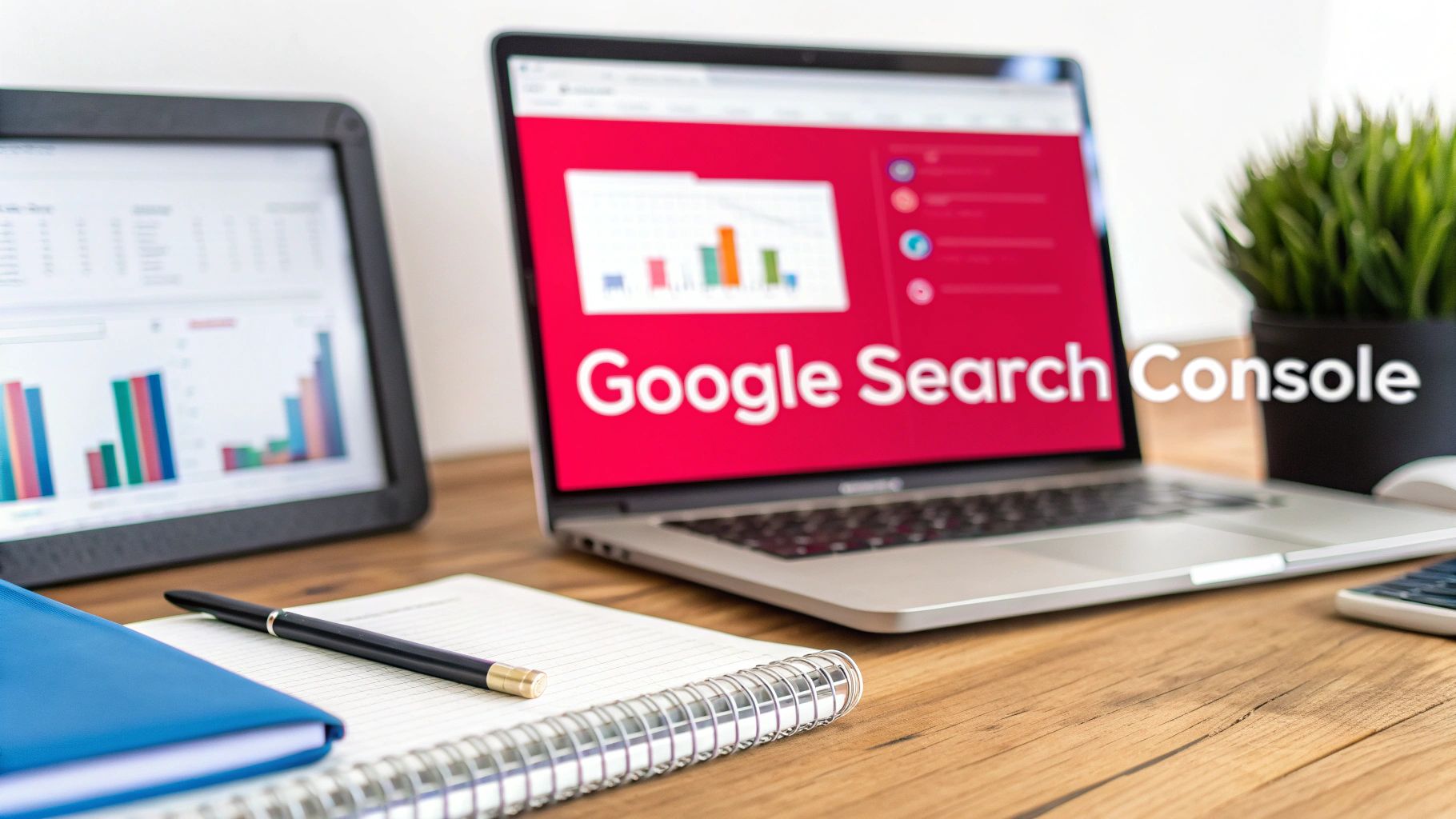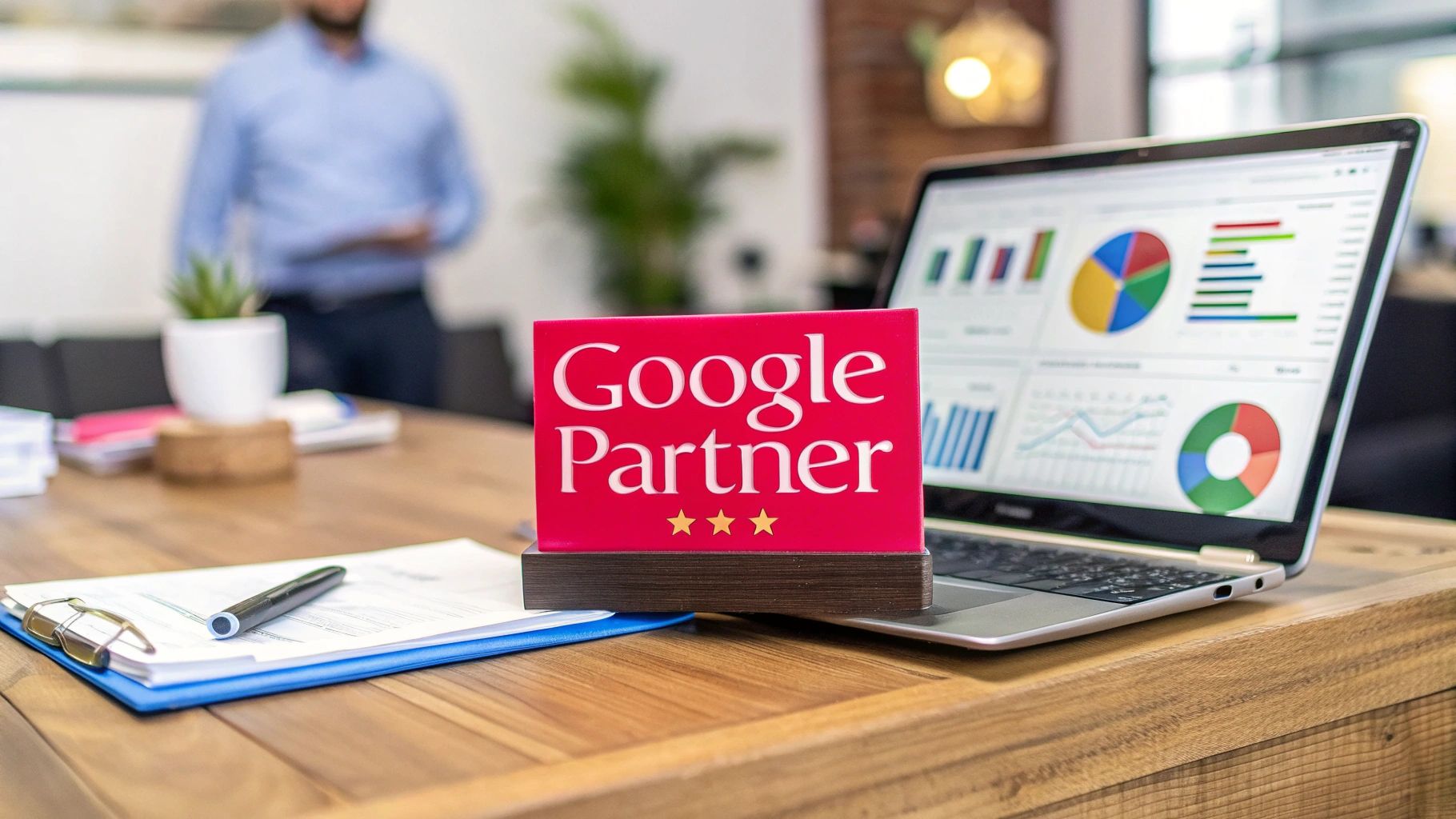Trying to make sense of all the different digital marketing services can feel a little overwhelming. It's like being handed the keys to a high-performance race car, a sturdy off-road truck, and a nimble city scooter all at once, without knowing which one to use for the journey ahead. SEO is your reliable, long-haul truck building steady momentum, while PPC is the speedboat getting you to specific destinations fast.
Mapping Your Path to Business Growth
This guide is designed to be your roadmap. We'll start with a bird's-eye view of the most essential services out there, clearing up the jargon and showing you how each part works. Think of this as the first step in building a powerful engine for your business, giving you the clarity needed to make smart decisions that actually line up with your goals.
The need for these skills is exploding. The marketing and advertising agency market in the Middle East and UAE was valued at around $7.81 billion in 2025 and is only expected to climb. This boom is fueled by businesses of all sizes going digital, pushing everyone to adopt smarter marketing strategies to stay competitive. You can get a deeper look at the Middle East marketing agency market on MarketReportAnalytics.com.
The Core Pillars of Digital Marketing
At the end of the day, a winning strategy isn't about picking one service off a menu; it's about getting multiple services to work together like a well-oiled machine. It’s all about creating a system that attracts, engages, and converts the right people.
Here’s a simple way to think about it:
- Attraction (Top of the Funnel): This is all about getting found. Services like Search Engine Optimization (SEO) and content marketing put your brand in front of people who are already looking for what you offer.
- Engagement (Middle of the Funnel): Once you have their attention, you need to keep it. This is where social media management and email marketing shine, helping you build real relationships and stay on their radar.
- Conversion (Bottom of the Funnel): This is the final step—turning prospects into customers. Pay-Per-Click (PPC) ads and sharp landing pages are built to capture that "ready-to-buy" intent and drive sales or leads.
The diagram below shows how these distinct services all fit under the broader digital marketing umbrella.

It’s a great visual reminder that while SEO, PPC, and social media are all different disciplines, they work best when they're part of one cohesive strategy.
When you get this right, each service makes the others stronger. For example, the data from a successful PPC campaign can give you incredible insights for your long-term SEO keyword strategy. This creates a feedback loop that constantly sharpens your approach and boosts your overall return on investment.
To give you a clearer picture, here's a quick rundown of the main services and what they're designed to do.
Overview of Key Digital Marketing Services
| Marketing Service | Primary Goal | Best For |
|---|---|---|
| Search Engine Optimization (SEO) | Increase organic visibility on search engines. | Building long-term, sustainable traffic and brand authority. |
| Pay-Per-Click (PPC) Advertising | Drive immediate, targeted traffic to a website. | Quick lead generation, promoting specific offers, testing keywords. |
| Social Media Marketing (SMM) | Build brand awareness and community engagement. | Fostering customer relationships and reaching niche audiences. |
| Content Marketing | Attract and retain an audience with valuable content. | Establishing thought leadership and nurturing leads over time. |
| Email Marketing | Nurture leads and drive repeat business. | Direct communication with interested prospects and existing customers. |
This table serves as a handy reference, but the real magic happens when you start combining these services to create a strategy tailored specifically to your business.
Climbing Search Rankings with SEO

Think of Google as the world's biggest, busiest library. When someone searches for something, they're asking the librarian (Google's algorithm) to find the absolute best book on that topic. Search Engine Optimization (SEO) is the craft of making sure your website is that book—the most relevant, authoritative, and helpful one on the shelf.
This isn't about gaming the system. It's about earning your spot at the top by genuinely providing the best answers and experience. The payoff? A consistent flow of organic traffic from people who are actively looking for exactly what you offer. It’s a cornerstone among all services for digital marketing because it builds a powerful, long-lasting asset for your business.
The Three Pillars of Modern SEO
A successful SEO strategy is like a three-legged stool. If one leg is weak, the whole thing topples over. To get lasting results, you have to understand how these three core pillars work together.
Here’s the breakdown:
- On-Page SEO: This is everything you control directly on your website—the quality of your content, the structure of your pages, and how well you guide visitors and search engines.
- Off-Page SEO: This is all about building your reputation across the web. Think of it as earning endorsements and positive reviews from other respected sources online.
- Technical SEO: This is the nuts and bolts of your website's foundation. It ensures search engines can find, crawl, and understand your site without hitting any roadblocks.
The real goal of SEO is to send strong signals to search engines that your website delivers the most value to users. When you nail that with great content and a flawless user experience, they reward you with top rankings, solidifying your brand as a trusted authority.
Mastering On-Page SEO Signals
On-page SEO is where you have the most hands-on control. It all starts with keyword research—getting inside your customers' heads to figure out the exact words and phrases they type into Google.
Once you know what they're searching for, you weave those terms naturally into the most important parts of your site: page titles, headings, meta descriptions, and of course, the content itself. For instance, a Dubai-based catering company would want to build pages around phrases like "corporate event catering Dubai" or "best wedding caterer in UAE."
But it's not just a keyword game anymore. A huge piece of the puzzle is creating a fantastic user experience. Google loves websites that load in a flash, are a breeze to navigate, and look great on a phone. In fact, with over 50% of all web traffic now coming from mobile devices, a clunky mobile site is no longer an option.
Building Authority with Off-Page SEO
Off-page SEO is largely about earning backlinks. A backlink is simply a link from someone else's website pointing to yours. In Google's world, a link from a reputable, relevant site is like a powerful vote of confidence.
Getting these high-quality backlinks is a strategic game. You might write a groundbreaking article that people can't help but link to, contribute a guest post to a well-known industry blog, or get your business featured in online news.
Remember, quality trumps quantity every time. A single backlink from a major industry authority is worth a hundred links from spammy, unknown blogs. This is how you prove your credibility and influence, which is absolutely critical for climbing the search rankings.
Capturing Immediate Demand with PPC Ads
While SEO is your long game for building organic authority, sometimes you just need results now. That's where Pay-Per-Click (PPC) advertising comes in.
Think of it this way: SEO is like building your own storefront in a great neighborhood and waiting for foot traffic to discover you over time. PPC is like paying to put a flashing neon sign right in the middle of Times Square, instantly grabbing the attention of people who are already there looking for exactly what you sell. You get immediate visibility.
This speed makes PPC an absolute powerhouse for things like new product launches, seasonal promotions, or any time you need to crank up the lead generation machine quickly. The concept is simple: you pay a small fee every time someone clicks your ad.
But these aren't just ads thrown into the wind. They show up right at the top of Google search results or in your target audience's social media feeds, targeted with laser-like precision. This means you're not wasting money; you're paying to reach people who are actively looking for a solution like yours.
How PPC Turns Clicks into Customers
At its heart, PPC runs on a bidding system. You pick the keywords your customers are searching for (or the demographics they fit into) and place a bid to have your ad show up. For instance, a local bakery might bid on "custom birthday cakes in Dubai." When someone types that into Google, the ads from the most relevant, highest bidders pop up first.
But it’s not purely a high-roller's game. Search engines actually reward good ads. They want their users to have a positive experience, so high-quality, relevant ads often get better placement even with a lower bid.
A killer PPC campaign is a well-oiled machine with a few critical parts:
- Strategic Keyword Selection: Getting inside your customer's head to know exactly what they're typing into the search bar.
- Compelling Ad Copy: Writing those short, punchy ads that are impossible to ignore.
- Optimized Landing Pages: Making sure the page a person "lands" on after clicking your ad is clean, clear, and guides them to take action.
- Precise Audience Targeting: Using data to show your ads only to the people who are most likely to buy.
The real magic of PPC is that everything is measurable. You can track every single click, view, and sale that comes from your ads. This gives you a crystal-clear picture of your return on investment and lets you tweak your campaigns on the fly, getting rid of the guesswork and focusing on what works.
Platforms and Practical Applications
When people think PPC, they usually think of Google Ads, and for good reason. It's the king of capturing "high-intent" users—the people who are actively searching with their wallets out. Getting your ad in front of them at that exact moment is one of the most direct ways to make a sale. Managing this effectively is a key reason businesses look for a professional PPC service in Dubai.
But the internet is bigger than just search engines. Social media platforms like Facebook, Instagram, and LinkedIn offer their own powerful PPC systems. Here, you can target people based on an incredible amount of detail:
- Their interests and hobbies (e.g., hiking, vintage cars)
- Their job titles or industry
- If they've visited your website before
- Their age, location, and much more
This makes social PPC fantastic for building brand awareness and connecting with niche audiences. These are the people who might not be searching for you yet, but are a perfect fit for your brand.
For a deeper dive into how this all works, you can explore some great resources on Pay Per Click (PPC) advertising. Ultimately, a smart strategy often uses both search and social PPC—one to capture the demand that exists today, and the other to build the customer base of tomorrow.
Building Your Brand with Content and Social Media

While SEO and PPC are fantastic for getting people to knock on your digital door, content and social media are what invite them in for a chat. These are the services for digital marketing that infuse your brand with personality, give it a voice, and make people want to stick around.
Think of content marketing less like a sales pitch and more like hosting an incredibly useful workshop. It's the art of creating and sharing genuinely helpful stuff—insightful blog posts, practical guides, engaging videos, or shareable infographics. The real goal isn't an immediate sale; it's to solve your audience's problems, answer their burning questions, and position your business as the go-to expert in your field.
Get this right, and you build an unshakable foundation of trust. People start to see you not just as a place that sells things, but as a reliable resource. That trust is priceless and often becomes the tipping point when they're finally ready to make a purchase.
Fueling Conversations with Social Media
If your content is the workshop, then social media marketing is the lively town square where everyone gathers to talk about it. This is where the real conversations spark, relationships are forged, and your brand’s personality truly shines. Just blasting out promotional posts won’t cut it; genuine engagement is the name of the game.
Social media gives you a direct line to your audience. You can ask them questions, run fun polls, respond to their comments, and even share their own content, all of which makes your followers feel seen and valued. With over 5.5 billion people now online, a huge chunk of them are on social platforms, making it an essential space for any brand to be.
The real magic happens when you sync up your content and social media. That one in-depth blog post can be sliced and diced into a dozen engaging social media updates, a video script, and a compelling infographic. It’s an integrated approach that makes sure your message stays consistent and reaches people wherever they hang out online.
This synergy creates a powerful feedback loop. You discover what your audience is passionate about from social media chatter, which in turn inspires the next great piece of content you create.
Creating a Unified Brand Voice
Nothing confuses an audience faster than a disjointed strategy. To really make an impact, your content and social media need to be in perfect harmony, speaking with one clear and consistent brand voice.
To nail this, focus on a few key elements:
- Tone and Personality: Is your brand buttoned-up and professional? Or is it more playful and witty? Whatever you choose, that tone needs to carry through from your blog to your Instagram stories and LinkedIn updates.
- Visual Identity: Use the same colors, logos, and fonts everywhere. This visual repetition makes your brand instantly recognizable in a fast-scrolling feed.
- Core Messaging: What are the key values and ideas you want to be known for? Make sure every single piece of content reinforces these core principles, building a brand identity that’s impossible to forget.
This level of consistency is what turns casual followers into a true community. When people know what to expect from you and they resonate with what you stand for, they’re much more likely to engage, share, and become your biggest fans.
Turning Followers into Brand Advocates
The ultimate aim is to build a community that doesn't just buy from you but actively champions your business. This is where a skilled team can be a game-changer. For expert help in building a thriving online community, working with a professional social media agency is a smart move.
A solid content and social media plan is designed to nurture this kind of loyalty. It all comes down to a few core activities:
- Providing Consistent Value: Regularly share content that educates, entertains, or inspires.
- Encouraging Interaction: Actively ask for opinions, run contests, and feature content from your followers.
- Being Responsive: Reply to comments and messages quickly and helpfully. It shows you’re listening and that you care.
By consistently delivering value and fostering real connections, you transform your audience from passive scrollers into passionate brand advocates. These loyal fans become your most powerful marketing tool, spreading your message with an authenticity that no paid ad can ever match.
Driving Strategy With Data and Automation

If you've ever wondered how modern marketing teams seem to be everywhere at once, the answer lies in dashboards like the one above. This isn't just a collection of charts; it's the control center where data and automation meet to turn guesswork into a calculated, intelligent strategy.
These days, flying blind in marketing just isn't an option. The powerful combination of data analytics and marketing automation acts as the brain and the central nervous system of any successful digital operation.
Think of data analytics as your campaign’s GPS. It doesn't just show you where you are; it gives you real-time feedback on what's working, who you're actually reaching, and which direction to head next. It’s the tool that translates a sea of raw numbers into a clear, actionable roadmap.
Turning Numbers Into Actionable Insights
Great analytics is so much more than just counting website visits or social media likes. It’s about digging deeper to understand the story the numbers are telling. A smart analytics strategy is designed to answer your most critical business questions.
For instance, which of your marketing channels consistently deliver your most profitable customers? Where, exactly, are people dropping off during the checkout process? Data gives you the definitive answers, so you can stop guessing, double down on what works, and patch the leaks in your sales funnel. This data-first approach is the bedrock of effective services for digital marketing.
Data analytics is what helps you shift the conversation from "We think this is working" to "We know this is working, and here’s the proof." It replaces vague assumptions with hard evidence, making it possible to prove your marketing ROI and make smarter decisions that drive real growth.
The market certainly reflects this shift. The digital marketing software sector in the Middle East and UAE, which covers analytics and automation, was valued around $3.893 billion and is expected to skyrocket to nearly $12.391 billion by 2033. This explosion in growth shows just how much businesses are relying on technology to get better results.
Scaling Your Efforts With Marketing Automation
If data analytics is the GPS, then marketing automation is the tireless assistant working for you 24/7. It’s the engine that handles all the repetitive, time-consuming tasks with perfect precision, freeing up your team to focus on what humans do best: strategy and creativity.
This technology is what allows you to deliver personalized experiences to thousands of people at once. It’s the magic behind an e-commerce store automatically sending a follow-up email with a discount code to someone who abandoned their shopping cart.
Common automation tasks include:
- Email Nurturing: Sending a carefully timed series of emails that guide a new lead from curiosity to conversion.
- Social Media Scheduling: Automatically posting your content at the perfect times to maximize reach and engagement.
- Lead Scoring: Ranking your prospects based on their engagement so your sales team can focus on the hottest leads first.
By setting up these automated workflows, you create a system that ensures no opportunity slips through the cracks. To really make this work, it’s essential to follow key marketing automation best practices. Integrating these tools is often a key piece of a much larger business puzzle, which is why many companies look for expert guidance on their overall strategy. You can see how this fits into the bigger picture by exploring https://grassrootscreativeagency.com/digital-transformation-consulting/.
Making AI a Part of Your Digital Marketing Toolkit
Artificial Intelligence isn't some far-off idea from a sci-fi movie anymore. It's here, and it’s completely changing how services for digital marketing get done. Think of AI less as a replacement for human marketers and more as an incredibly smart partner—one that handles the heavy lifting so you can focus on strategy and creativity.
The real magic of AI is its ability to shift from reacting to what customers do to predicting what they'll do next. Sophisticated algorithms can chew through mountains of data to pinpoint which customers might be about to leave, what products are about to take off, and what people truly want. It’s like having a data-driven crystal ball, giving you a serious leg up on the competition.
Boosting Both Creativity and Efficiency
One of the most immediate ways AI helps is with content and ad creation. Need a dozen different versions of ad copy or a handful of catchy email subject lines? AI tools can spit them out in seconds. This doesn't mean the human touch is obsolete; it just means marketers can skip the tedious brainstorming and get straight to refining the final message.
AI is also a master of optimization. For paid ad campaigns, it can tweak bids in real-time, 24/7, automatically shifting your budget to the ads that are performing best. This ensures every single dollar is working as hard as it possibly can—a level of constant, micro-level adjustment that a human team could never manage.
The New Era of Hyper-Personalization
The dream for most brands is to make every customer feel seen and understood. AI turns that dream into a scalable reality through hyper-personalization.
We're talking about more than just putting someone's first name in an email. AI looks at a person's entire digital footprint—their browsing habits, past purchases, and how they click around your site—to deliver truly customized experiences.
- Dynamic Website Content: Imagine a website that shows different product suggestions or headlines to visitors based on what they've shown interest in before.
- Personalized Email Journeys: AI can trigger automated email sequences that change and adapt based on whether a user opens, clicks, or ignores a message.
- Smarter Product Suggestions: It's the engine behind those "you might also like" sections on e-commerce sites that feel almost psychic.
By getting to know customers on an individual level, AI helps brands move past generic, one-size-fits-all marketing and build genuine connections through conversations that actually matter to each person.
This isn't just a trend; it's a massive shift. By 2024, over 60% of businesses in the UAE had already woven AI into their marketing strategies. As third-party cookies fade away, the ability of AI to make the most of your own customer data is becoming more critical than ever. To get a better handle on how to integrate artificial intelligence into your strategy, you can learn how to use AI for marketing to drive real growth.
Frequently Asked Questions
Diving into the world of services for digital marketing can feel a bit overwhelming. Lots of questions pop up when you're trying to make the right moves for your business. We get it. Below, we've tackled some of the most common questions to give you the clarity you need to push forward.
Where Should a Small Business Start?
For most small businesses, the smartest place to start is with a solid foundation of SEO and targeted content marketing. It's a bit like building a house—you need to get the foundation and framework right before you can think about decorating.
Start by getting your website optimized and publishing genuinely helpful content. This two-pronged approach begins to establish your authority and pulls in organic traffic from people actively looking for what you offer. Best of all, it builds a long-term asset without needing a huge ad budget right out of the gate.
Once that foundation is solid, you can start layering on other channels like social media or small-scale PPC campaigns to get results faster. The golden rule is to own your home base first.
How Long Does It Take to See Results?
This is the million-dollar question, and the honest answer is: it depends entirely on the service.
If you need speed, Pay-Per-Click (PPC) advertising is your best bet. It can start driving traffic and leads almost instantly, sometimes within hours of launching a campaign.
SEO, however, is a marathon, not a sprint. You're playing the long game. It usually takes a good three to six months before you start seeing real, meaningful traction in search rankings and organic traffic. Content and social media marketing fall somewhere in the middle, gaining momentum over several weeks and months as your audience and library of content grow.
A classic mistake we see is businesses giving up on SEO or content way too early. Think of it like a high-yield savings account: the initial deposits might seem small, but their value compounds over time, leading to a massive, sustainable payoff.
How Do I Measure Marketing Success?
Measuring success is all about tracking the right Key Performance Indicators (KPIs) for each service. The key is to look past "vanity metrics" like raw follower counts or likes and focus on the numbers that actually impact your bottom line.
Here’s what that looks like in practice:
- For SEO: Don't just watch rankings. Track the growth in your organic traffic and, most critically, how many of those visitors turn into leads or sales.
- For PPC: The two most important metrics here are Cost Per Acquisition (CPA) and Return on Ad Spend (ROAS). These tell you exactly how much it costs to land a new customer and how much revenue your ad dollars are generating.
- For Content Marketing: Go beyond page views. Look at things like time on page, how many people sign up for your newsletter after reading a blog post, or the conversion rate of content-driven traffic.
Focusing on these performance-based KPIs gives you a crystal-clear, data-backed view of what's working and where your marketing budget is making the biggest impact.
Ready to build a digital marketing strategy that actually drives results? At Grassroots Creative Agency, we create data-supported plans that are built around your unique business goals. Contact us today to get started.








